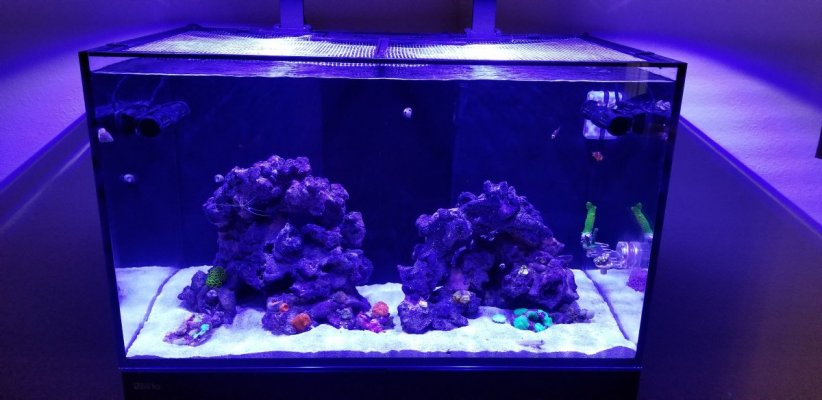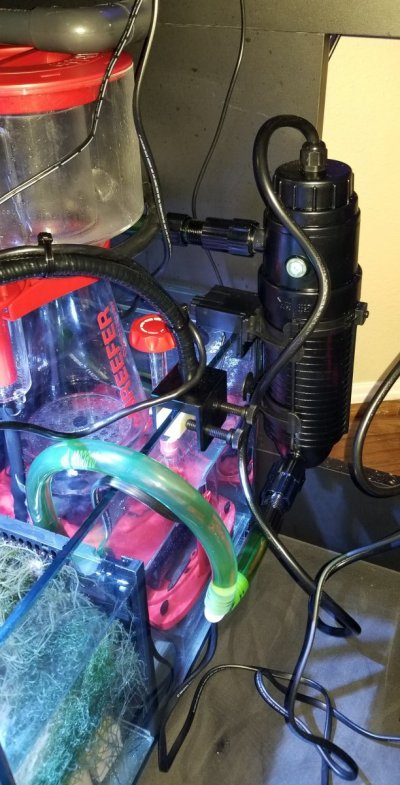Hey all. I'm not particularly new to the hobby (2 years experience), but I've only set up two tanks before and wanted to look for insight on how to best establish the current tank. I'm working on a red sea reefer xl300 using marco's dry rock. The tank was stared on 9/26/2020. It was cycled using microbacter xlm, dr tims one and only, and microbacter 7 with ammonia from Dr. Tim's. Multiple bacterial cultures listed above were used to increase microbial diversity and provide a larger initial population. Cycling was complete (0 ammonia, 0 nitrite, 5ppm nitrate) by 10/19/2020 when 3 ignitus anthias were added. Turned on the skimmer at this point (runs wet, emptied and cleaned weekly) and added filter and mesh socks (changed weekly). Still performing 10% weekly water changes. Two weeks later I transferred two clowns from my old tank to this one. Lights were turned on about 10/26/2020 and are two AI 32s run using David Saxby's settings. Tank reads 0, 0, 0 for the last 2 weeks. This is likely due to the appearance of algae, diatoms, and cyano. Once these showed up (two weeks ago) I added in quarantined chaetomorpha and switched on a tunze fuge light on a oppositing night cycle. I also added the cleanup crew at this point - about 15 nerite snails of various sizes, 30 small cereith snails, 10 small nassarius snails, 10 baby trochus (useless but cute), 3 astrea, and 2 hermit crabs (I hate these *#$&!). I would have more but shipment from reef cleaners was delayed by a day in cold weather by fedex, half the order was dead and was not pleased with customer service on shippers end though I've used him exclusively. Currently looking for new supplier.
I am using sand (not live), but seeded with sand from my established tank (2 years old). Unsurprisingly, this is where the algae, diatoms, and cyano started and radiated outward from. Sand is 2 inches deep in most areas with a 3-4 inch deep section in a corner that is intended for a yellow coris wrasse in the future. Water turnover rate is 15x via return and two reefwave 25s create turbulant flow throughout the tank with a focal point that changes throughout the day.
With all of that said... I've not dealt with the uglies successfully in a long time. What I'm looking for are tips on how to successfully manage the algae, diatoms, and cyano with my current setup. I'd like to try to avoid any extra equipment at this time, but would like input on livestock to add, techniques to try, or if I should just let it do its thing. Its probably worth mentioning that I'm opposed to getting temporary inhabitants. These creatures have enough to go through when ordered and put in my tank, the stress of doing that again and again isn't a life that I want to subject them to personally. Additionally this is going to be a tank stocked with entirely peaceful fish (my clowns are incredibly well behaved) and while a mixed reef is going to be acro dominant.
I look forward to any insights or suggestions on how to proceed.
Cheers and thanks!

I am using sand (not live), but seeded with sand from my established tank (2 years old). Unsurprisingly, this is where the algae, diatoms, and cyano started and radiated outward from. Sand is 2 inches deep in most areas with a 3-4 inch deep section in a corner that is intended for a yellow coris wrasse in the future. Water turnover rate is 15x via return and two reefwave 25s create turbulant flow throughout the tank with a focal point that changes throughout the day.
With all of that said... I've not dealt with the uglies successfully in a long time. What I'm looking for are tips on how to successfully manage the algae, diatoms, and cyano with my current setup. I'd like to try to avoid any extra equipment at this time, but would like input on livestock to add, techniques to try, or if I should just let it do its thing. Its probably worth mentioning that I'm opposed to getting temporary inhabitants. These creatures have enough to go through when ordered and put in my tank, the stress of doing that again and again isn't a life that I want to subject them to personally. Additionally this is going to be a tank stocked with entirely peaceful fish (my clowns are incredibly well behaved) and while a mixed reef is going to be acro dominant.
I look forward to any insights or suggestions on how to proceed.
Cheers and thanks!



















